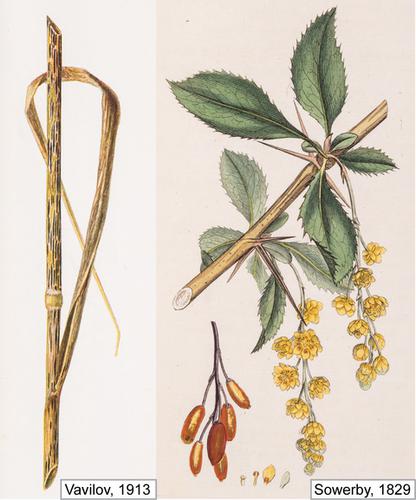当前位置:
X-MOL 学术
›
Plant Pathol.
›
论文详情
Our official English website, www.x-mol.net, welcomes your
feedback! (Note: you will need to create a separate account there.)
Banishing barberry: the history of Berberis vulgaris prevalence and wheat stem rust incidence across Britain
Plant Pathology ( IF 2.3 ) Pub Date : 2020-06-29 , DOI: 10.1111/ppa.13231 Gerry Barnes 1 , Diane G. O. Saunders 2 , Tom Williamson 1
Plant Pathology ( IF 2.3 ) Pub Date : 2020-06-29 , DOI: 10.1111/ppa.13231 Gerry Barnes 1 , Diane G. O. Saunders 2 , Tom Williamson 1
Affiliation

|
Wheat stem rust, caused by the fungus Puccinia graminis f. sp. tritici (Pgt), is a notoriously damaging disease of wheat and barley. Pgt requires two hosts to complete its lifecycle; undergoing asexual reproduction on cereal crops and completing sexual reproduction on Berberis spp. The latter stage of its lifecycle is of particular importance in temperate regions such as western Europe, where asexual urediniospores are unable to survive cold winter weather. In the past, the crucial role of Berberis in the lifecycle of stem rust led to intensive eradication campaigns, initially carried out by farmers in the face of hostile scientific opinion. In the United Kingdom, common barberry (Berberis vulgaris) is today a relatively rare plant. Stem rust is, however, currently experiencing a resurgence; at the same time, there has been a general increase in the prevalence of barberry and an upsurge in its planting which, in the United Kingdom, is associated with attempts to encourage the endangered barberry carpet moth (Pareulype berberata). This article situates current developments within a broader chronological framework, examining changing attitudes towards barberry and rust in England in the past and the history of the plant's use and cultivation. It assesses how widespread B. vulgaris really was in the environment historically, and thus the scale of its eradication. We suggest that Berberis was never widely established as an archaeophyte in the United Kingdom. Current attempts to re-establish it are based on a misunderstanding of the plant's historical status and could potentially pose a serious threat to food security.
中文翻译:

放逐小檗:英国小檗流行史和小麦茎锈病发病率
小麦茎锈病,由真菌 Puccinia graminis f 引起。sp. 小麦 (Pgt) 是一种众所周知的小麦和大麦破坏性病害。pgt 需要两台主机才能完成其生命周期;在谷类作物上进行无性繁殖并在小檗属上完成有性繁殖。其生命周期的后期在西欧等温带地区尤为重要,那里的无性孢子无法在寒冷的冬季天气中生存。过去,小檗在茎锈病生命周期中的关键作用导致了密集的根除运动,最初由农民在面对敌对的科学观点时进行。在英国,小檗 (Berberis vulgaris) 今天是一种相对稀有的植物。然而,茎锈病目前正在卷土重来。同时,在英国,小檗的流行率普遍增加,种植量激增,这与鼓励濒临灭绝的小檗地毯蛾 (Pareulype berberata) 的尝试有关。本文将当前的发展置于更广泛的时间顺序框架内,检查过去英国对小檗和铁锈病的态度变化以及该植物的使用和栽培历史。它评估了 B. vulgaris 历史上在环境中的真实分布情况,从而评估了其根除的规模。我们认为,小檗从未在英国广泛确立为一种考古植物。目前重建它的尝试是基于对工厂历史地位的误解,可能对粮食安全构成严重威胁。
更新日期:2020-06-29
中文翻译:

放逐小檗:英国小檗流行史和小麦茎锈病发病率
小麦茎锈病,由真菌 Puccinia graminis f 引起。sp. 小麦 (Pgt) 是一种众所周知的小麦和大麦破坏性病害。pgt 需要两台主机才能完成其生命周期;在谷类作物上进行无性繁殖并在小檗属上完成有性繁殖。其生命周期的后期在西欧等温带地区尤为重要,那里的无性孢子无法在寒冷的冬季天气中生存。过去,小檗在茎锈病生命周期中的关键作用导致了密集的根除运动,最初由农民在面对敌对的科学观点时进行。在英国,小檗 (Berberis vulgaris) 今天是一种相对稀有的植物。然而,茎锈病目前正在卷土重来。同时,在英国,小檗的流行率普遍增加,种植量激增,这与鼓励濒临灭绝的小檗地毯蛾 (Pareulype berberata) 的尝试有关。本文将当前的发展置于更广泛的时间顺序框架内,检查过去英国对小檗和铁锈病的态度变化以及该植物的使用和栽培历史。它评估了 B. vulgaris 历史上在环境中的真实分布情况,从而评估了其根除的规模。我们认为,小檗从未在英国广泛确立为一种考古植物。目前重建它的尝试是基于对工厂历史地位的误解,可能对粮食安全构成严重威胁。











































 京公网安备 11010802027423号
京公网安备 11010802027423号